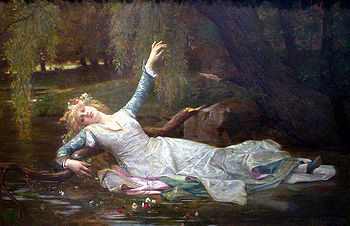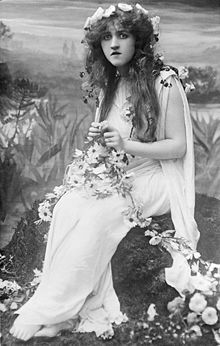- Ophelia
-
For other uses, see Ophelia (disambiguation).
Ophelia 
John William Waterhouse's painting Ophelia (1894)Creator William Shakespeare Play Hamlet Family Polonius (father)
Laertes (brother)Ophelia is a fictional character in the play Hamlet by William Shakespeare. She is a young noblewoman of Denmark, the daughter of Polonius, sister of Laertes, and potential wife of Prince Hamlet.
Contents
Plot
In Ophelia's first speaking appearance in the play, [1] we see her with her brother, Laertes, who is leaving for France. Laertes warns her that Hamlet, the heir to the throne of Denmark, does not have the freedom to marry whomever he wants. Ophelia's father, Polonius, enters while Laertes is leaving, and also forbids Ophelia to pursue Hamlet, whom he fears is not earnest about her.
In Ophelia's next appearance,[2] she tells Polonius that Hamlet rushed into her room with his clothing askew, and with a "hellish" expression on his face, and only stared at her and nodded three times, without speaking to her. Based on what Ophelia tells him, about Hamlet acting in such a "mad" way, Polonius concludes that he was wrong to forbid Ophelia to see Hamlet, and that Hamlet must be mad because of lovesickness for Ophelia. Polonius immediately decides to go to Claudius (the new King of Denmark, and also Hamlet's uncle and stepfather) about the situation. Polonius later suggests[3] to Claudius that they hide behind an arras to overhear Hamlet speaking to Ophelia when Hamlet thinks the conversation is private. Since Polonius is now sure that Hamlet is lovesick for Ophelia, he thinks Hamlet will express love for Ophelia. Claudius agrees to try the eavesdropping plan later.
The plan leads to what is commonly called the 'Nunnery Scene'.[4] Polonius instructs Ophelia to stand in the lobby of the castle while he and Claudius hide. Hamlet enters the room, in a different world from the others, and recites his "To be, or not to be" soliloquy. Hamlet approaches Ophelia and talks to her. He tells her "get thee to a nunnery." Hamlet becomes angry, realizes he has gone too far, and says "I say we will have no more marriages", and exits. Ophelia is left bewildered and heartbroken, sure that Hamlet is insane. After Hamlet storms out, Ophelia makes her "O, what a noble mind is here o'erthrown" soliloquy.
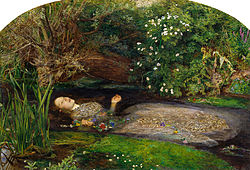 Ophelia by John Everett Millais (1852) is part of the Tate Gallery collection. His painting influenced the image in Kenneth Branagh's Hamlet
Ophelia by John Everett Millais (1852) is part of the Tate Gallery collection. His painting influenced the image in Kenneth Branagh's Hamlet
The next time Ophelia appears is at the 'Mousetrap Play'[5] which Hamlet has arranged to try to prove that Claudius killed King Hamlet. Hamlet sits with Ophelia and makes sexually suggestive remarks, also saying that woman's love is brief.
Later that night, after the play, Hamlet kills Polonius [6] during a private meeting between Hamlet and his mother, Queen Gertrude. At Ophelia's next appearance,[7] after her father's death, she has gone mad, due to what the other characters interpret as grief for her father. She talks in riddles and rhymes, sings some "mad" and bawdy songs about death and a maiden losing her virginity. After bidding everyone a "good night", she exits.
The final time Ophelia appears in the play is after Laertes comes to the castle to challenge Claudius over the death of his father, Polonius. Ophelia sings more songs and hands out flowers, citing their symbolic meanings although interpretations of the meanings differ. The only herb that Shakespeare gives Ophelia herself is rue; "... there's rue for you, and here's some for me; we may call it herb of grace o'Sundays; O, you must wear your rue with a difference". Rue is well known for its symbolic meaning of regret, but the herb is also highly poisonous and has powerful abortive properties.[8]
Ophelia by Alexandre Cabanel
In Act 4 Scene 7, Queen Gertrude, in her monologue (There is a willow grows aslant the brook), reports that Ophelia had climbed into a willow tree, and then a branch broke and dropped Ophelia into the brook, where she drowned. Gertrude says that Ophelia appeared "incapable of her own distress". Gertrude's announcement of Ophelia's death has been praised as one of the most poetic death announcements in literature.[9]
We later see a sexton at the graveyard insisting Ophelia must have killed herself.[10] Laertes is outraged by what the cleric says, and replies that Ophelia will be an angel in heaven when the cleric "lie[s] howling" in hell.
At Ophelia's funeral, Queen Gertrude sprinkles flowers on Ophelia's grave ("sweets to the sweet,") and says she wished Ophelia could have been Hamlet's wife. Laertes then jumps into Ophelia's grave excavation, asking for the burial to wait until he has held her in his arms one last time and proclaims how much he loved her. Hamlet, nearby, then challenges Laertes and claims that he loved Ophelia more than "forty thousand" brothers could. After her funeral scene, Ophelia is no longer mentioned.
Portrayal
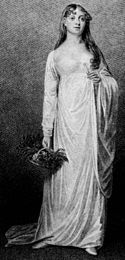 Mary Catherine Bolton (afterwards Lady Thurlow) (1790-1830) as Ophelia in 1813, opposite John Philip Kemble's Hamlet
Mary Catherine Bolton (afterwards Lady Thurlow) (1790-1830) as Ophelia in 1813, opposite John Philip Kemble's Hamlet
While it is known that Richard Burbage played Hamlet in Shakespeare's time, there is no evidence of who played Ophelia; since there were no professional actresses on the public stage in Elizabethan England, we may be certain that she was played by a boy.[11]
The early modern stage in England had an established set of emblematic conventions for the representation of female madness: dishevelled hair worn down, dressed in white, bedecked with wild flowers, Ophelia's state of mind would have been immediately 'readable' to her first audiences.[12] "Colour was a major source of stage symbolism", Andrew Gurr explains, so the contrast between Hamlet's "nighted colour" (1.2.68) and "customary suits of solemn black" (1.2.78) and Ophelia's "virginal and vacant white" would have conveyed specific and gendered associations.[13] Her action of offering wild flowers to the court suggests, Showalter argues, a symbolic deflowering, while even the manner of her 'doubtful death', by drowning, carries associations with the feminine (Laertes refers to his tears on hearing the news as "the woman").
Gender structured, too, the early modern understanding of the distinction between Hamlet's madness and Ophelia's: melancholy was understood as a male disease of the intellect, while Ophelia would have been understood as suffering from erotomania, a malady conceived in biological and emotional terms.[14] This discourse of female madness influenced Ophelia's representation on stage from the 1660s, when the appearance of actresses in the English theatres first began to introduce "new meanings and subversive tensions" into the role: "the most celebrated of the actresses who played Ophelia were those whom rumor credited with disappointments in love."[15] Showalter relates a theatrical anecdote that vividly captures this sense of overlap between a performer's identity and the role she plays:
The greatest triumph was reserved for Susan Mountfort, a former actress at Lincoln's Inn Fields who had gone mad after her lover's betrayal. One night in 1720 she escaped from her keeper, rushed to the theater, and just as the Ophelia of the evening was to enter for her mad scene, "sprang forward in her place ... with wild eyes and wavering motion." As a contemporary reported, "she was in truth Ophelia herself, to the amazement of the performers as well as of the audience—nature having made this last effort, her vital powers failed her and she died soon after."[16]
During the 18th century, the conventions of Augustan drama encouraged far less intense, more sentimentalized and decorous depictions of Ophelia's madness and sexuality. From Mrs Lessingham in 1772 to Mary Bolton, playing opposite John Kemble in 1813, the familiar iconography of the role replaced its passionate embodiment. Sarah Siddons played Ophelia's madness with "stately and classical dignity" in 1785.[17]
Since that time, Ophelia has been a frequent subject in artwork, often in a Romantic or Classical style, as the images on this page show.
Many great actresses have played Ophelia on stage over the years. In the 19th century she was portrayed by Helen Faucit, Dora Jordan, Frances Abington, and Peg Woffington, who won her first real fame by playing the role.[18] Theatre manager Tate Wilkinson declared that next to Susannah Maria Cibber, Elizabeth Satchell (of the famous Kemble family) was the best Ophelia he ever saw.[19]
Ophelia has been portrayed on screen since the days of early silent films. Dorothy Foster played Ophelia opposite Charles Raymond's Hamlet in the 1912 film Hamlet. Jean Simmons played Ophelia opposite Laurence Olivier's Oscar-winning Hamlet performance in 1948; Simmons was also nominated for the Academy Award for Best Supporting Actress. More recently, Ophelia has been portrayed by Helena Bonham Carter (1990), Kate Winslet (1996), Julia Stiles (2000) and Gugu Mbatha-Raw (2009). Themes associated with Ophelia have led to movies such as Ophelia Learns to Swim (2000), and Dying Like Ophelia (2002).[20]
In many theatre and film adaptations she is portrayed barefoot in the mad scenes, including Kozintsev's 1964 version, Zeffirelli's 1990 film, 1996 and 2000 versions.
Psychologist, Mary Pipher, attributed the name of her 1994 #1 New York Times best selling book, Reviving Ophelia, to Shakespeare's Ophelia. In her book, Pipher examines the troubled lives of the modern American adolescent girls. Through her extensive clinical work with troubled young women, Pipher takes a closer look at the competing influences that lead adolescent girls in a negative direction. For example, Pipher attributes the competing pressure from parents, peers, and the media for girls to reach an unachievable ideal. Girls are expected to meet thing goal while still holding on to their sanity. These pressures are further complicated when young women undergo physical changes out of their control, like the biological developmental changes in puberty. Shakespeare's Ophelia was thought to be going through erotomania; however, Ophelia and Pipher's patients display many of the same characteristics. Pipher believes the Ophelia of Shakespeare's era was entirely misunderstood, much like the girls in her book. In order to understand the complex mind of an adolescent, one must look at the woman from a holistic perspective in order to gain a greater understanding of her outlook on life.
See also
- References to Ophelia
- Henrietta Rae
Footnotes
- ^ Hamlet, Act 1, Scene 3
- ^ Hamlet, Act 2, Scene 1
- ^ Hamlet, Act 2, Scene 2
- ^ Hamlet, Act 3, Scene 1
- ^ Hamlet, Act 3, Scene 2
- ^ Hamlet, Act 3, Scene 4
- ^ Hamlet, Act 4, Scene 5
- ^ http://www.sisterzeus.com/ERC_Rutin.html
- ^ For one example of praise see "The Works of Shakespeare," in 11 volumes (Hamlet in volume 10,) edited by Henry N. Hudson, published by James Munroe and Company, 1856: “This exquisite passage is deservedly celebrated. Nothing could better illustrate the Poet’s power to make the description of a thing better than the thing itself, by giving us his eyes to see it with.”
- ^ Hamlet, Act 5, Scene 1
- ^ Taylor (2002, 4); Banham (1998, 141); Hattaway asserts that "Richard Burbage [...] played Hieronimo and also Richard III but then was the first Hamlet, Lear, and Othello" (1982, 91); Peter Thomson argues that the identity of Hamlet as Burbage is built into the dramaturgy of several moments of the play: "we will profoundly misjudge the position if we do not recognize that, whilst this is Weiner Hamlet talking about the groundlings, it is also Burbage talking to the groundlings" (1983, 24); see also Thomson (1983, 110) on the first player's beard. A researcher at the British Library feels able to assert only that Burbage "probably" played Hamlet; see its page on Hamlet.
- ^ Showalter (1985, 80-81). In Shakespeare's King John (1595/6), the action of act three, scene four turns on the semiotic values of hair worn up or down and disheveled: Constance enters "distracted, with her hair about her ears" (17); "Lady, you utter madness, and not sorrow", Pandolf rebukes her (43), yet she insists that "I am not mad; this hair I tear is mine" (45); she is repeatedly bid to "bind up your hairs"; she obeys, then subsequently unbinds it again, insisting "I will not keep this form upon my head / When there is such disorder in my wit" (101-102).(
- ^ Gurr (1992, 193) and Showalter (1985, 80-81).
- ^ Showalter (1985, 80-81).
- ^ Showalter (1985, 80, 81).
- ^ Showalter (1985, 81-82).
- ^ Showalter (1985, 82).
- ^ William Cullen Bryant & Evert A. Duyckinck (eds.), The Complete Works of Shakespeare, 1888
- ^ Some aspects of provincial drama in the eighteenth centuryFrederick T. Wood English Studies, Volume 14, Issue 1 - 6 1932 (p. 73)
- ^ Internet Movie Database, imdb.com
References
- Banham, Martin, ed. 1998. The Cambridge Guide to Theatre. Cambridge: Cambridge University Press. ISBN 0521434378.
- Charney, Maurice. 2000. Shakespeare on Love & Lust. New York: Columbia University Press. ISBN 0231104294.
- Gurr, Andrew. 1992. The Shakespearean Stage 1574-1642. Third ed. Cambridge: Cambridge University Press. ISBN 052142240X.
- Hattaway, Michael. 1982. Elizabethan Popular Theatre: Plays in Performance. Theatre Production ser. London and Boston: Routledge and Kegan Paul. ISBN 0710090528.
- Thomson, Peter. 1983. Shakespeare's Theatre. Theatre Production ser. London and Boston: Routledge and Kegan Paul. ISBN 0710094809.
- Wells, Stanley, and Sarah Stanton, eds. 2002. The Cambridge Companion to Shakespeare on Stage. Cambridge Companions to Literature ser. Cambridge: Cambridge University Press. ISBN 052179711X.
External links
- 'Shakespeare's Ophelia?', Rob Sharp, The Independent, 8 June 2011
- 'Five Truths', directed by Katie Mitchell created for the Victoria and Albert Museum, 12 July 2011
William Shakespeare's Hamlet Characters 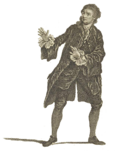
Soliloquies Sources & Criticism - Legend of Hamlet
- The Spanish Tragedy
- Ur-Hamlet
- Critical approaches
- Bibliographies
Influence Performances Adaptations Hamlet on screen Categories:- Fictional characters introduced in 1600
- Characters in Hamlet
- Female Shakespearean characters
- Fictional nobility
- Fictional Danish people
Wikimedia Foundation. 2010.

